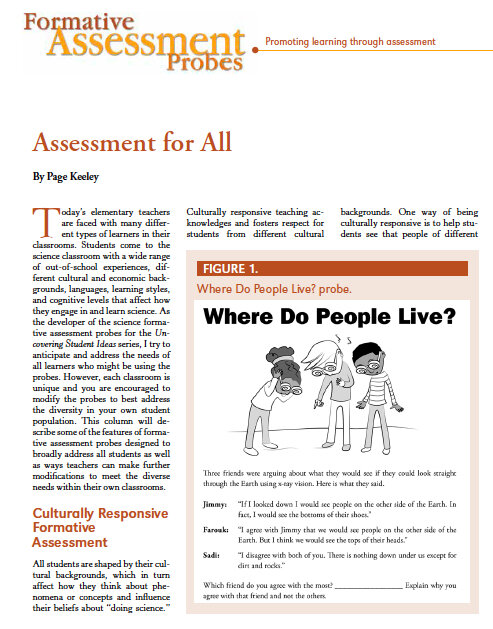Journal Articles
Page Keeley writes a monthly column for the NSTA Science and Children journal on using formative assessment probes in K-6 classrooms. These articles can be accessed for free online using your NSTA membership number. If you are not an NSTA member, these articles can be purchased individually through the NSTA Learning Center. Articles for each annual collection are described below with a link to the book the probe appears in. These articles can expand your capacity to use formative assessment probes effectively. They can also be used for professional learning discussions.
2020 Articles
Feb 2020- Doing Science vs. Doing Engineering; Probes: Doing Science, How Do Engineers Solve Problems?
Apr/May 2020- Uncovering Parents’ and Childrens’ Ideas in Science; Probe: Shadow Size
Sept/Oct 2020- Using Formative Assessment Probes with Real or Virtual Field Trips; Probe: Land or Water?
2019 Articles
Jan 2019- Apple in the Dark- Using Metacognitive Strategies; Probe: Apple in the Dark
Feb 2019-Balance Beam-Figuring Out a Mathematical Rule; Probe: Balance Beam
Mar 2019- Describing the Motion of a Marble- Staying True to the Purpose of a Formative Assessment Probe; Probe: Marble Roll
Apr 2019- Formative Assessment Probes- Our Best Thinking So Far; Probe: Can a Plant Break Rocks?
Aug 2019- Supporting Literacy Capacities of Speaking and Listening; Probe: Solids, Liquids, and Gases
Sept 2019- Using the 6Es and Formative Assessment Probes to Differentiate Instruction; Probe: No Shadow
2018 Articles
Jan 2018- Uncovering Representations of the Water Cycle; Probe: Wet Jeans
Feb 2018-Uncovering Student Ideas About Inherited Traits; Probe: Baby Mice
Mar 2018- Uncovering “Maker” Ideas About Sound; Probe: Making Sound
Apr 2018- Uncovering Students’ Ideas About Watersheds; Probe: What Is a Watershed?
Jul 2018- Using Formative Assessment Probes to Develop Elementary Learning Stations; Probe: Can You Pick It Up with a Magnet?
Aug 2018- Formative Assessment Probes- Is a Brick a Rock? Probe: Is a Brick a Rock?
Nov 2018- Magnets in Water- Using a Talk-Listen-Restate Scaffold to Support Productive Talk and Careful Listening; Probe: Magnets in Water
2017 Articles
Sept 2017- Preservice Teachers’ Ideas About Magnetism and Formative Assessment; Probe: Can You Pick It Up?
Oct 2017- Uncovering Young Children’s Concept of a Plant; Probe: Is It a Plant?
Nov 2017- Vocabulary in Context; Probe: Is It an Amphibian?
Dec 2017-Embedding Formative Assessment into the 5E Model; Probe: Lemonade
2016 Articles
Jan 2016- Uncovering Students’ Concept of Matter; Probe: Is It Matter?
Mar 2016- Is It Erosion or Weathering?; Probe: Is It Erosion?
Apr 2016- Talk Moves; Probe: Watermelon and Grape
Jul 2016- Big and Small Seeds; Probe: Big and Small Seeds
2015 Articles
Jan 2015- Ice Cubes in a Bag; Probe: Ice Cubes in a Bag
Mar 2015- Soil and Dirt- Same or Different? Probe: Describing Soil
Jul 2015- Snap Blocks- Parts and Wholes; Probe: Snap Blocks
Sept 2015- Where Do I Put the Switch? Probe: Where Do I Put the Switch?
Oct 2015- Wet Jeans- Using Familiar Phenomena to Uncover Student Thinking; Probe: Wet Jeans
Nov 2015- Constructing Cl-Ev-R Explanations to Formative Assessment Probes; Probe: Lemonade
Dec 15- Mountaintop Fossil- A Puzzling Phenomenon; Probe: Mountaintop Fossil
2014 Articles
Jan 2014- Assessment for All; Probe: Where Do People Live?
Mar 2014- Habitat Change: Formative Assessment of a Cautionary Word; Probe: Habitat Change
Sept 2014- Is It a Theory- Speaking the Language of Science; Probe: Is It a Theory?
Nov 2014- Seeds in a Bag; Probe: Seeds in a Bag
Dec 14- Watermelon and Grape- An Intuitive Rule of Quantity and Proportion; Probe: Watermelon and Grape
2013 Articles
Jan 2013- Using the P-E-O Technique; Probe: Solids and Holes
Feb 2013- Labeling vs. Explaining; Probe: Chrysalis
Mar 2013- When Equipment Gets in the Way; Probe: Battery, Bulb, and Wires
Apr 2013- Is It a Rock? Continuous Formative Assessment; Probe: Is It a Rock?
Jul 2013- Is It a Solid? Claim Cards and Argumentation; Probe: Is It a Solid?
Sept 2013- When Is the Next Full Moon? Using K-2 Concept Cartoons; Probe: When Is the Next Full Moon?
Oct 2013- Pendulums and Porch Swings- Connecting Science and Engineering; Probe: Swinging Pendulum
Nov 2013- Is It Melting? Formative Assessment for Teacher Learning; Probe: Is It Melting?
Dec 2013- Is It Made of Parts? Scaffolding a Formative Assessment Probe; Probe: Is It Made of Parts?
2012 Articles
Jan 2012- Daytime Moon- Is Seeing Believing?; Probe: Objects in the Sky
Feb 2012- Can It Reflect Light? Probe: Can It Reflect Light?
Apr/May 2012- Food for Plants- A Bridging Concept:; Probe: Is It Food for Plants?
Jul 2012- Where Did the Water Go?; Probe: Where Did the Water Come From?
Sept 2012- Confronting Common Folklore- Catching a Cold; Probe: Catching a Cold
Oct 2012- Talking About Shadows; Probe: Me and My Shadow
Nov 2012- Birthday Candles- Visually Representing Ideas; Probe: Birthday Candles
Dec 2012- Mountain Age- Creating a Classroom Profile; Probe: Mountain Age
2011 Articles
Jan 2011- How Far Did It Go? Probe: How Far Did It Go?
Feb 2011- Needs of Seeds; Probe: Needs of Seeds
Mar 2011- The Mitten Problem; Probe: The Mitten Problem
Apr 2011- Is It Living? Probe: Is It Living?
Jul 2011- With a Purpose; Describes several techniques for using probes
Sept 2011- Where Are the Stars? Probe: Emmy’s Moon and Stars
Oct 2011- Pushes and Pulls; Probe: Talking About Forces
Nov 2011-Teachers as Researchers; Probe: Is It an Animal?
Dec 2011- Representing Microscopic Life; Probe: Pond Water
2010 Articles
Sept 2010- Doing Science; Probe: Doing Science
Oct 2010- “More A-More B” Intuitive Rule; Probe: Floating Log
Nov 2010- Does It Have a Life Cycle? Probe: Does It Have a Life Cycle?
Dec 2010- To Hypothesize or Not; Probe: What Is a Hypothesis?











